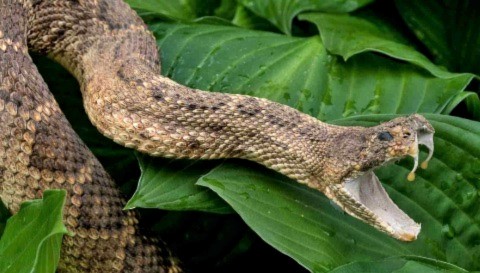Why The King Destroyed a Copper Snake

Growing up on the East Coast, I was never afraid of garden snakes, which I occasionally discovered in my backyard.
When I moved to California and started hiking in the mountains, I encountered my first rattlesnake. Although I did not panic, I developed healthy respect for these poisonous reptiles.
Snakes play a pivotal role in this week’s Torah portion, Chukas (Numbers 19:1-22:1). While in the Sinai Desert, God provided for the needs of the Jewish people. Nevertheless, the Jews complained when they grew “sick and tired of the [manah] light bread” God had given them. In response, God “released burning venomous snakes that bit the people and many people died” (Numbers 21:5-6).
These “burning” snakes allude to the primordial snake that entices people to burn with an unrestrained passion for pleasure and excitement. This lack of self-control led to their dissatisfaction with God’s gifts and God’s punitive response.
Those who had not succumbed to the poison confessed their transgression and asked Moses to pray to God that they be healed. God instructed Moses to “make a copper serpent and place it on a high pole, and all who gaze at the copper snake will live” (Numbers 21:9).
This story used to confuse me. On the one hand, how could God prohibit graven images and, on the other hand, request that Moses make a copper snake? This apparent contradiction provides an important spiritual lesson.
Graven images are forbidden when we adorn, worship, and rely on them. In the case of the copper snake, the lesson was to recognize that graven images are powerless and that the true power of healing comes from God. Our sages discussed this point in the context of another episode in Jewish history when the Jewish people battled the Amalekites.
Moses sat on a hill during the battle, and “whenever Moses held up his hand, Israel prevailed, and whenever he lowered his hand, Amalek prevailed” (Exodus 17:11).
Our sages explain that Moses’ hands were not a magic wand or a talisman, saying, “Did the hands of Moses make the battle, or did his hands break the battle? Rather, as long as Israel gazed upward and directed their hearts to their Father in Heaven, they prevailed; but when not, they fell” (Talmud, Rosh Hashanah 29a). Moses’ hands were pointed toward heaven to remind the Jews to rely on God’s Divine help.
The Talmud continues to explain that, similarly, the copper snake was placed on a “high pole” so that it would also serve to direct the Jewish people’s hearts to God. “Does the serpent kill or does the serpent grant life? Rather, as long as Israel gazed upward and subjugated their hearts to their Father in Heaven, they were healed.”
This spiritual lesson reminds us that we should direct our prayer only to God and not make the mistake of worshiping intermediaries. With this in mind, the sages praised the righteous King Hezekiah, who destroyed the copper snake in the 6th century BCE because certain Jews mistakenly attributed divine healing powers to this inanimate object rather than to God (Talmud, Pesachim 56a; II Kings 18:4).
Moreover, this explains why Moses was revered but not worshiped. Moses, who is described as “exceedingly humble” (Numbers 12:3), desired only that the Jewish people learn from him to direct their prayers to God alone.
Misdirected allegiances have been a pitfall for many people. Some worshiped the sun, stars, trees, and even bugs, while others worshiped humans whom they considered God in the flesh. The Torah declares, “Watch yourselves very carefully, since you saw no form on the day that the Lord spoke to you at Horeb [Mt. Sinai] out of the midst of the fire, lest you become corrupt and make for yourselves a graven image of any shape, the likeness of male or female” (Deuteronomy 4:15-16). Furthermore, the prophet Jeremiah bemoaned this behavior when he said, “Can a man make gods for himself? Yet they are not gods” (Jeremiah 16:20).
Our personal relationship with our infinite God provides us with an immediate and intimate connection with the Almighty, Who transcends all finite limitations, including human form.
This Shabbos, may we be blessed to seek and find God through thoughtful prayer and meditation; as King Solomon said, “Those who seek Me shall find Me” (Proverbs 8:17).
Shabbat Shalom,
Rabbi Bentzion Kravitz
© 2023 Jews for Judaism ● P.O. Box 351235, Los Angeles, CA 90035 ● 310-556-3344
[email protected] ● www.jewsforjudaism.org/donate ● www.SMARTalks.com
 Why the King Destroyed a Copper Snake
Why the King Destroyed a Copper Snake